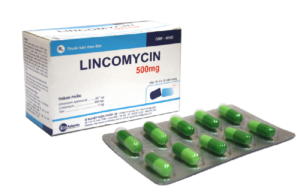 Lincomycin is a broad-spectrum antibiotic, so it is used quite often in the therapy of diseases that were provoked by Gram-positive bacteria.
Lincomycin is a broad-spectrum antibiotic, so it is used quite often in the therapy of diseases that were provoked by Gram-positive bacteria.
The mechanism of action of this medication may differ when taking the drug at low and high concentrations.
Contents
- Pharmacological action
- Forms of release
- How to apply the drug?
- Use of
- tablets Intramuscular and intravenous injections
- Intended use in dentistry
- Side effects and contraindications
- Purchase of
- Patient's opinion
Pharmacological action
Lincomycin belongs to the antimicrobial antibacterial drugs that make up the group of lincosamides. The active ingredient is lincomycin hydrochloride monohydrate. 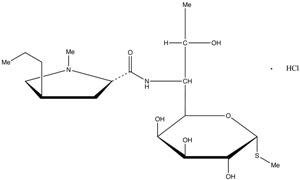
A characteristic feature of the remedy is its pronounced bacteriostatic action( stopping the reproduction of microbes) with the use of minimal and medium doses and an obvious bactericidal effect( destruction of pathogenic microorganisms) with increasing dosage.
By acting on inflammatory bacteria, the agent suppresses the process of protein synthesis in their cells, causing disruption of peptide bonds.
With inflammation in the oral cavity, this drug helps neutralize the negative effect of green streptococci, which is present in the plaque and provokes the development of carious processes. The success of therapy is explained by the duration of the achieved positive effect, since pathogenic microorganisms are not able to quickly develop resistance to the preparation.
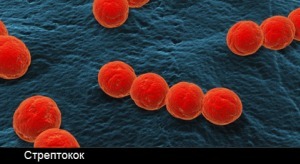 The agent is practically not used if the inflammatory process is caused by gram-negative bacteria, viruses, protozoa and fungi due to the resistance of virtually all types of such microorganisms to this medication.
The agent is practically not used if the inflammatory process is caused by gram-negative bacteria, viruses, protozoa and fungi due to the resistance of virtually all types of such microorganisms to this medication.
Another feature of the drug is its accumulation in the bone tissue, so that the concentration of the active substance necessary for recovery freely enters the periodontal tissue and the affected tooth.
Forms of release
Antibiotic is available in the following forms:
-
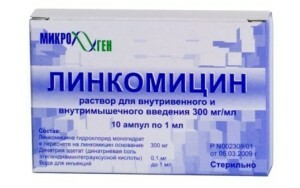 capsules( tablets);
capsules( tablets); - ampoules with lyophilizate from which a solution is prepared for intramuscular or intravenous injection;
- plasters;
- ointment.
How to apply the drug?
The instructions for use differ depending on the form of the release of Linkomycin.
Use of tablets
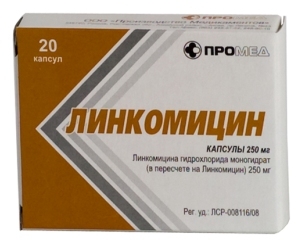 When the drug is prescribed in capsules to adult patients, it should be taken three times a day for 500 mg( two capsules), sometimes the frequency of reception increases up to 4 times.
When the drug is prescribed in capsules to adult patients, it should be taken three times a day for 500 mg( two capsules), sometimes the frequency of reception increases up to 4 times.
Usually, therapy is carried out for 7-14 days. If there are signs of osteomyelitis, the course can be stretched for 3 weeks or more. The drug is taken a couple of hours before a meal, with plenty of water. In the treatment of children, the dosage is determined by calculating 30-60 mg per kilogram of body weight.
The effectiveness of absorption of the drug is determined by the loading of the stomach. The maximum absorption( by 30%) is noted in a hungry stomach.
Intramuscular and intravenous injections
Usually injections are performed in the diagnosis of severe inflammation. In such situations, adult patients are injected intramuscularly once or twice daily for 600 mg.
Intravenous infusions are carried out drip with the same frequency in a similar dosage. For children, the required amount of the drug is calculated on the basis of the need to administer 10-20 mg of funds per kilogram of the child's weight.
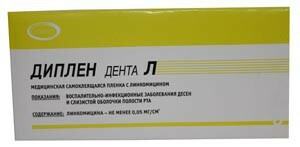 Plasters with Linkomycin, called Diplent-Denta-L, may differ depending on the type of film that the dentist should choose correctly. The patch has a two-sided structure and consists of a hydrophobic and hydrophilic layers.
Plasters with Linkomycin, called Diplent-Denta-L, may differ depending on the type of film that the dentist should choose correctly. The patch has a two-sided structure and consists of a hydrophobic and hydrophilic layers.
The first is necessary to protect the sealed area from getting unnecessary particles, and the second is characterized by moisture resistance, so it is easily fixed on the gum. After 6-8 hours after attachment, the patch is removed.
Among the features of the application can be noted the complete incompatibility of the drug with alcohol.
Intended use in dentistry
Therapy with medication is performed in the following situations:
-
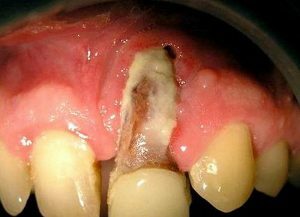
infectious inflammation of the tissues of the maxillofacial apparatus;
- development of purulent processes, the formation of abscesses and fistulas during periodontitis, periodontitis. Lidocaine may be administered concomitantly with lincomycin;
- preventing the development of secondary infection in the open wound after extraction( removal) of the tooth;
- severe forms of ulcerative gingivitis;
- appearance of signs of osteomyelitis.
Also, solutions with the addition of Lincomycin are used to rinse the mouth with a prophylactic purpose to prevent the development of caries.
Side effects and contraindications
Lincomycin is not used when:
- is hypersensitive to the active substance;
- impaired renal and hepatic function;
- pregnancy and lactation due to the free overcoming of the placental barrier.
In the treatment of this antibiotic, the following negative changes in the functioning of the body can be observed:
-

disruption of the hematopoiesis system in the form of neutropenia, thrombocytopenia or leukopenia;
- development of stomatitis, glossitis;
- disruption of the digestive tract in the form of nausea, vomiting, epigastric pain, pseudomembranous colitis;
- allergic reaction with the development of Quincke's edema, exfoliative dermatitis, anaphylactic shock.
In case of intravenous administration, rapid delivery of the agent should be avoided in order to avoid the appearance of general weakness and relaxation of skeletal muscles, dizziness, lowering of arterial pressure, development of phlebitis.
Purchase of
The price may vary depending on the form of the preparation. So, the agent in the form of a solution in ampoules for injections and tablets( capsules) on average cost about 50-90 rubles.
The most expensive is the Diplen plaster, the price of which reaches almost 500 rubles.
Opinion of patients
What consumers think about the Lincomycin product can be learned by reviewing their reviews.
The first three days from the beginning of the drug were passed without any discomfort, the fourth one started with severe diarrhea.
After taking appropriate medications, the condition returned to normal, but signs of a dysbiosis in the form of flatulence still remained. The dentist recommended probiotics to restore useful intestinal microflora.
Dmitry, Moscow
I've been injecting injections of Lincomycin intramuscularly for two days to treat gum disease. While it was not possible to achieve a complete lowering of the temperature, but now it does not rise above 38 degrees, thanks to which half a day I am in a working condition.
Sergey, Yelets
When she turned to the dentist because of a discomfort in the gum area, he diagnosed the onset of the inflammatory process. With therapeutic purpose, ultrasonic teeth cleaning was performed and Lincomycin was appointed. As a result, after 7 days the signs of inflammation completely disappeared.
Ekaterina, Dubno
In order to use the medication only to benefit and not to harm the body, it is necessary to strictly follow the doctor's recommendations regarding the dosage and intake of the necessary concomitant medications.
Only in this case, a positive result will not keep you waiting, and the condition of the oral cavity will return to normal without the risk of repeated relapse.
If you are prescribed an intramuscular injection of the drug, and you do not have time to visit the polyclinic, learn how to do the injections yourself.
